The Nazi genocide of the Sinti and Roma
and the long struggle for recognition
and the long struggle for recognition
The Nazi genocide
of the Sinti and Roma and the
long struggle for recognition
of the Sinti and Roma and the
long struggle for recognition
„Racial Diagnosis:Gypsy“
Oskar and Vinzenz Rose: trailblazers of the civil rights movement
The first initiatives by the Sinti and Roma in the Federal Republic of Germany that were aimed at politically organising the minority were launched by the brothers Oskar and Vinzenz Rose. In 1956, they founded an interest group of people of non-Jewish faith who had been persecuted on racial grounds. It was followed in 1971 by the Central Committee of the Sinti of West Germany, established by Vinzenz Rose (which later became the Association of German Sinti). Initially, these early associations had little public resonance.
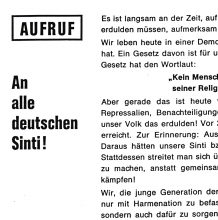
01 | First call to action by the Central Committee of the Sinti of West Germany (1971/1972) Documentation Centre Archives
01
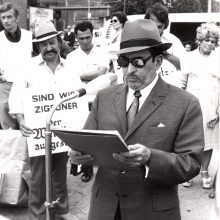
02.1 | The first political rally by German Sinti was held in Heidelberg on 18 June 1973 in response to the shooting of 53-year-old Sinto Anton Lehmann by the police on 31 May 1973. The hundred or so demonstrators called for the police officer responsible to be sanctioned and for an end to discriminatory practices. […]
02.1

02.2 | The first political rally by German Sinti was held in Heidelberg on 18 June 1973 in response to the shooting of 53-year-old Sinto Anton Lehmann by the police on 31 May 1973. The hundred or so demonstrators called for the police officer responsible to be sanctioned and for an end to discriminatory practices. […]
02.2
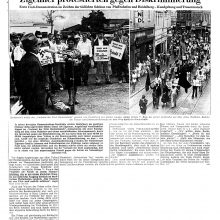
02.3 | Article in the Rhein-Neckar-Zeitung of 19 June 1973 covering the rally in Heidelberg Rhein-Neckar-Zeitung Archives
02.3
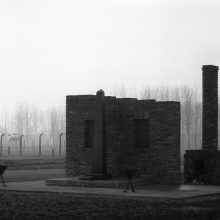
03.1 | In 1973 Vinzenz Rose used his own funds to pay for a monument to be erected on the grounds of the former ‘gypsy camp’ at Auschwitz-Birkenau. Its purpose was to commemorate all the Sinti and Roma who had been murdered there. Bricks taken from all the prisoners’ buildings located in this section of […]
03.1
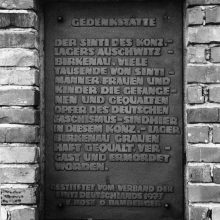
03.2 | In 1973 Vinzenz Rose used his own funds to pay for a monument to be erected on the grounds of the former ‘gypsy camp’ at Auschwitz-Birkenau. Its purpose was to commemorate all the Sinti and Roma who had been murdered there. Bricks taken from all the prisoners’ buildings located in this section of […]
03.2



